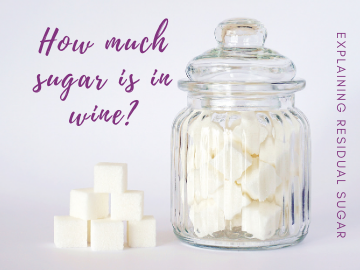Whether we like it or not, sugar is a big part of our lives. We eat it, drink it, make homemade facial scrubs from it – sugar is everywhere! Including our wine. It’s an integral part of the winemaking process since it’s the grape’s natural sugars which are fermented into alcohol. But does that mean a ready-to-drink bottle of wine contains all alcohol and zero sugar? No. Most bottles of wine have what we call Residual Sugar. So how do we find out how much sugar is in wine? Unfortunately, it’s not an easy answer. But I’m here to guide you in the right direction.
Understanding Brix and the Grape’s Sugar
Before we get into sugar that’s in the bottle, we need to establish its origin – the grape! Winemakers spend weeks leading up to harvest measuring the grapes Brix levels. And because I’m not a scientist, here’s Wikipedia’s definition of what that is.
“Degrees Brix (symbol °Bx) is the sugar content of an aqueous (water) solution. One degree Brix is 1 gram of sucrose in 100 grams of solution and represents the strength of the solution as percentage by mass.”
Wikipedia
Essentially, Brix levels measure optimum ripeness. When the levels are reached, the grapes are picked!
From Degrees Brix to Residual Sugar
Through the winemaking process, yeast is added to the grape juice which eats away at the sugars, creating alcohol. Assuming the aim is a dry wine, they’ll let fermentation finish resulting in an average alcohol percentage (usually 11-14%) and a low residual sugar (0-15 grams per litre RS).
How Residual Sugar Compares to other Common Drinks
Sugar levels, or any nutritional information, aren’t legally required on any alcohol beverage label. Fortunately, many producers know that this information is sought after, so they’ll often provide technical information on their website. So, if it’s sugar levels you’re after, it’s time to do some research.
Here are a few well-known wines and their residual sugar levels against some comparative beverages.
Santa Julia Reserva Malbec: 3.9 g/L RS
Cono Sur Bicicleta Chardonnay: 4.5 g/L RS
Kim Crawford Sauvignon Blanc: 5 g/L RS
Yellow Tail Shiraz: 12 g/L RS
Apothic Red: 15 g/L RS
iced tea: approx. 88g/L (or 22/cup)
apple juice: approx. 96 g/L (or 24g/cup)
Coca-Cola: approx. 110 g/L (39g per can)
Anything higher than 15 g/L RS is an off-dry or semi-dry wine (think German Riesling or a Gewurztraminer). In comparison, a dessert wine (ice wine or port-style) will have upwards of 120 g/L residual sugar.
Just Enjoy the Damn Wine
Now that you’re a wealth of knowledge when it comes to residual sugar, what do you do? You could further your research to find out how RS relates to calories and carbohydrate intake. Personally, I like the ‘ignorance is bliss’ mentality. Just enjoy the damn wine!

